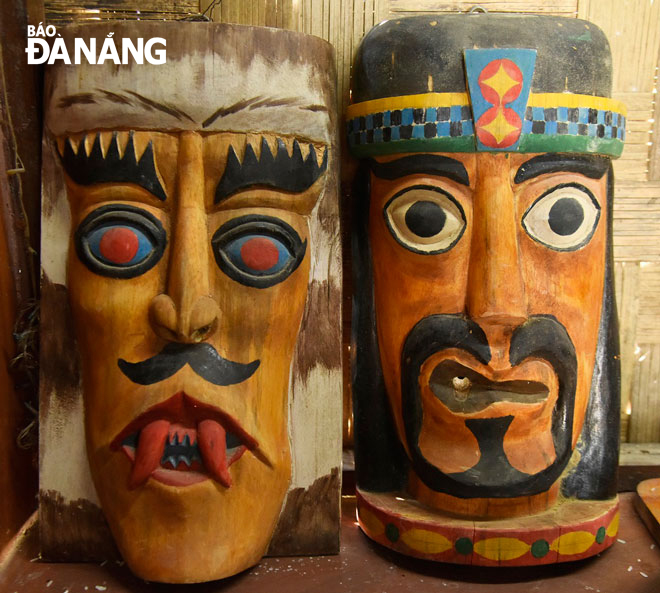Unique wooden mask of Co Tu ethnic group in Da Nang
The wood carving art works of the Co Tu people are associated with spiritual life and folk beliefs. In particular, the art of mask sculpture bears the original imprint. In mountainous areas where the Co Tu ethnic group live such as Dong Giang and Nam Giang in Quang Nam Province, the statues, reliefs, and ancient masks are disappearing. But the interesting thing is that the Co Tu people in Ta Lang Village, Hoa Bac Commune, Hoa Vang District, Da Nang, still keep a collection of masks created by artisans in the time-honoured village.
 |
| Here is a mask with the ferocious face. Photo: T.V |
The wooden masks here are large, about 25cm wide about 35cm long. In terms of style, it still retains the soul and essence of the Co Tu mask. From the main parts on the mask such as eyes, nose, mouth to other details such as forehead, cheeks and chin are all stylised with wild contours.
These are relatively perfect masks, having their own nuances in shaping and carving and showing off a smooth combination of the art of carving and using colours.
Besides the typical traditional colours such as white, red and black, there are also many others such as blue and yellow. Another unique detail is that the neck acts as a base. The neck is painted with the image of onyx jewelry rings like the traditional costume of the Co Tu people. The village's sculptors have carved, coloured and painted each mask, creating such expressive features.
Two different types of faces can be seen in the wooden masks: the evil and the benign faces. The evil mask shows a ferocious personality with a peculiar shape such as having two sharp horns on its head, a red protruding tongue, showing sharp fangs and big-eyed stare. This type was previously used by warriors in battles with enemies.
On the contrary, the benign mask shows a friendly and close look. To create such a gentle face, artisans do not paint with many colours but chisel in a gentle and honest way. This type of mask bears the mark of gentle faces, reflecting benevolence, cheerfulness, closeness, embodiment of positive faces, bringing love and trust to the villagers in the community as a benevolent and kind-hearted village elder, dignified and talented young man.
The ancestors of the Co Tu people believe that ugly and aggressive masks show off power and force devils to run away in terror. Carving on hard wood is a difficult job as sculptors use knives and axes to create imaginary faces. A little mistake could damage the work. Therefore, only the best artisans are assigned to create the art.
Like the ethnic minorities in the highlands, the Co Tu ethnic people in Hoa Bac Commune consider masks as an item related to the gods. It is kept in a solemn place in the Guol house, which is a place for members of the village council (Tacooh puol) to discuss important issues and for the organisation of traditional village festivals.
Worshiping offerings such as rice, salt, fruit, cakes, betel nuts, arecas and lime are placed in front of the masks. This shows that wooden masks are not only for display but also related to sacred, solemn worshiping rituals and beliefs of the Co Tu people here.
For the time being, only Co Tu artist Truong Thanh My, 66, still knows how to make wooden masks. Maybe this is one of the last artisans of the Co Tu people who still excel in this craft.
Compared to other Southeast Asian countries like Malaysia and Indonesia, their residents always cherish and preserve the original art form. As the case of young artisan Samry, from the Mah Mery tribe of the Orang Asli minority group specialising in making wooden masks, has been named ‘mastercratfman’.
He was sent to the capital city of Kuala Lumpur, Europe and China to participate in international, national and regional events to demonstrate the practice of carving wooden masks. Wooden masks are a "brand name" of the village, introduced and promoted as a product to develop tourism, especially for foreign tourists.
Wooden masks of the Co Tu people are rare ethnographic artifacts, only found in some highland villages in Quang Nam Province’s Tay Giang District and Da Nang’s Ta Lang Village. Some ancient masks have been collected, kept and displayed by the Viet Nam Museum of Ethnology, the museums of Da Nang and Quang Nam.
With artistic values, wooden masks are still kept here as hidden gems. The creators of these works and the community that owns them need the support of the authorities at all levels and functional sectors to preserve and promote the cultural characteristics of the Co Tu ethnic group.
Reporting by TAN VINH - Translating by A.THU